经典NLP案例 | 推文评论情绪分析:从数据预处理到模型构建的全面指南
NLP经典案例:推文评论情绪提取
项目背景
“My ridiculous dog is amazing.” [sentiment: positive]
由于所有推文每秒都在传播,很难判断特定推文背后的情绪是否会影响一家公司或一个人的品牌,因为它的病毒式传播(积极),或者因为它的负面基调而破坏利润。在决策和反应在几秒钟内创建和更新的时代,用语言捕捉情感非常重要。但是,哪些词实际上导致了情感描述呢?在本次比赛中,您需要选出推文中反映情绪的部分(单词或短语)。
利用这个广泛的推文数据集帮助您培养在这一重要领域的技能。努力提高你的技术,在这场比赛中占据榜首。推文中的哪些词语支持积极、消极或中立的情绪?您如何使用机器学习工具帮助做出决定?
在本次比赛中,我们从 Figure Eight 的 Data for Everyone 平台中提取了支持短语。该数据集的标题为“情感分析:具有现有情感标签的文本推文中的情感”,此处在知识共享署名 4.0 下使用。国际许可证。你在这次比赛中的目标是构建一个可以做同样事情的模型 - 查看给定推文的标记情绪,并找出最能支持它的单词或短语。
目录
- EDA(数据探索性分析)
- 语料库清洗
- 词频可视化
- 词云图
- NER模型建立
关于本项目
在此笔记中,我将简要解释数据集的结构。我将生成并分析元特征。然后,我将使用 Matplotlib、seaborn 和 Plotly 可视化数据集,以获得尽可能多的见解。我还将把这个问题作为 NER 问题来处理来构建模型
导入必要的库
import re
import string
import numpy as np
import random
import pandas as pd
import matplotlib.pyplot as plt
import seaborn as sns
%matplotlib inline
from plotly import graph_objs as go
import plotly.express as px
import plotly.figure_factory as ff
from collections import Counterfrom PIL import Image
from wordcloud import WordCloud, STOPWORDS, ImageColorGeneratorimport nltk
from nltk.corpus import stopwordsfrom tqdm import tqdm
import os
import nltk
import spacy
import random
from spacy.util import compounding
from spacy.util import minibatchimport warnings
warnings.filterwarnings("ignore")import os
for dirname, _, filenames in os.walk('/kaggle/input'):for filename in filenames:print(os.path.join(dirname, filename))# 您写入当前目录的任何结果都将保存为输出。
下面是一个辅助函数,它生成随机颜色,可用于为您的绘图提供不同的颜色。随意使用它
def random_colours(number_of_colors):'''随机颜色生成的简单函数。输入:number_of_colors -指示将生成的颜色数量的整数值。输出:采用以下格式的颜色: ['#E86DA4'] 。'''colors = []for i in range(number_of_colors):colors.append("#"+''.join([random.choice('0123456789ABCDEF') for j in range(6)]))return colors
读取数据
本项目数据集来源于kaggle竞赛平台,可公众号后台回复“推文情绪”即可获取数据集
train = pd.read_csv('/kaggle/input/tweet-sentiment-extraction/train.csv')
test = pd.read_csv('/kaggle/input/tweet-sentiment-extraction/test.csv')
ss = pd.read_csv('/kaggle/input/tweet-sentiment-extraction/sample_submission.csv')
print(train.shape)
print(test.shape)
(27481, 4)
(3534, 3)
所以我们在训练集中有 27486 条推文,在测试集中有 3535 条推文
train.info()
<class 'pandas.core.frame.DataFrame'>
RangeIndex: 27481 entries, 0 to 27480
Data columns (total 4 columns):
textID 27481 non-null object
text 27480 non-null object
selected_text 27480 non-null object
sentiment 27481 non-null object
dtypes: object(4)
memory usage: 858.9+ KB
我们在训练中有一个空值,因为值的测试字段是 NAN,我们将删除它
train.dropna(inplace=True)
test.info()
<class 'pandas.core.frame.DataFrame'>
RangeIndex: 3534 entries, 0 to 3533
Data columns (total 3 columns):
textID 3534 non-null object
text 3534 non-null object
sentiment 3534 non-null object
dtypes: object(3)
memory usage: 83.0+ KB
测试集中不存在空值
EDA(数据探索性分析)
train.head()
Selected_text 是文本的子集
train.describe()
让我们看看推文在训练集中的分布
temp = train.groupby('sentiment').count()['text'].reset_index().sort_values(by='text',ascending=False)
temp.style.background_gradient(cmap='Purples')
| sentiment | text | |
|---|---|---|
| 1 | neutral | 11117 |
| 2 | positive | 8582 |
| 0 | negative | 7781 |
plt.figure(figsize=(12,6))
sns.countplot(x='sentiment',data=train)

让我们画一个漏斗图以获得更好的可视化效果
fig = go.Figure(go.Funnelarea(text =temp.sentiment,values = temp.text,title = {"position": "top center", "text": "Funnel-Chart of Sentiment Distribution"}))
fig.show()
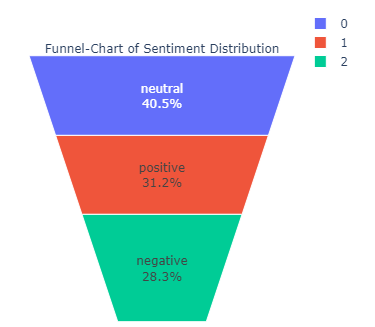
目前我们对数据了解多少:
在开始之前,让我们看一下我们已经了解的有关数据的一些知识,这些知识将帮助我们获得更多新的见解:
- 我们知道 selected_text 是文本的子集
- 我们知道 selected_text 只包含一段文本,即,它不会在两个句子之间跳转。例如:-如果文本是“在与供应商的会议中度过了整个上午,而我的老板对此不满意”他们。很有趣。 我早上还有其他计划”所选文本可以是“我的老板对他们不满意”。很有趣”或“很有趣”,但不能是“早上好,供应商和我的老板,
- 我们知道中性推文的文本和 selected_text 之间的 jaccard 相似度为 97%
- 另外,有些行中 selected_text 从单词之间开始,因此 selected_texts 并不总是有意义,因为我们不知道是否测试集的输出是否包含这些差异,我们不确定预处理和删除标点符号是否是一个好主意
生成元特征
在本笔记本的先前版本中,我使用所选文本和主要文本中的单词数、文本中的单词长度和选择作为主要元特征,但在本次比赛的背景下,我们必须预测 selected_text 这是一个文本的子集,生成的更有用的功能将是:
- Selected_text 和 Text 的字数差异
- 文本和 Selected_text 之间的 Jaccard 相似度分数
因此,生成我们之前使用过的特征对我们来说没有用,因为它们在这里并不重要
以下是 Jaccard 相似度的介绍:https://www.geeksforgeeks.org/find-the-jaccard-index-and-jaccard-distance-Between-the-two-given-sets/
def jaccard(str1, str2): a = set(str1.lower().split()) b = set(str2.lower().split())c = a.intersection(b)return float(len(c)) / (len(a) + len(b) - len(c))
results_jaccard=[]for ind,row in train.iterrows():sentence1 = row.textsentence2 = row.selected_textjaccard_score = jaccard(sentence1,sentence2)results_jaccard.append([sentence1,sentence2,jaccard_score])
jaccard = pd.DataFrame(results_jaccard,columns=["text","selected_text","jaccard_score"])
train = train.merge(jaccard,how='outer')
train['Num_words_ST'] = train['selected_text'].apply(lambda x:len(str(x).split())) #Number Of words in Selected Text
train['Num_word_text'] = train['text'].apply(lambda x:len(str(x).split())) #Number Of words in main text
train['difference_in_words'] = train['Num_word_text'] - train['Num_words_ST'] #Difference in Number of words text and Selected Text
train.head()
我们看一下Meta-Features的分布
hist_data = [train['Num_words_ST'],train['Num_word_text']]group_labels = ['Selected_Text', 'Text']# 使用自定义 bin_size 创建 distplot
fig = ff.create_distplot(hist_data, group_labels,show_curve=False)
fig.update_layout(title_text='Distribution of Number Of words')
fig.update_layout(autosize=False,width=900,height=700,paper_bgcolor="LightSteelBlue",
)
fig.show()
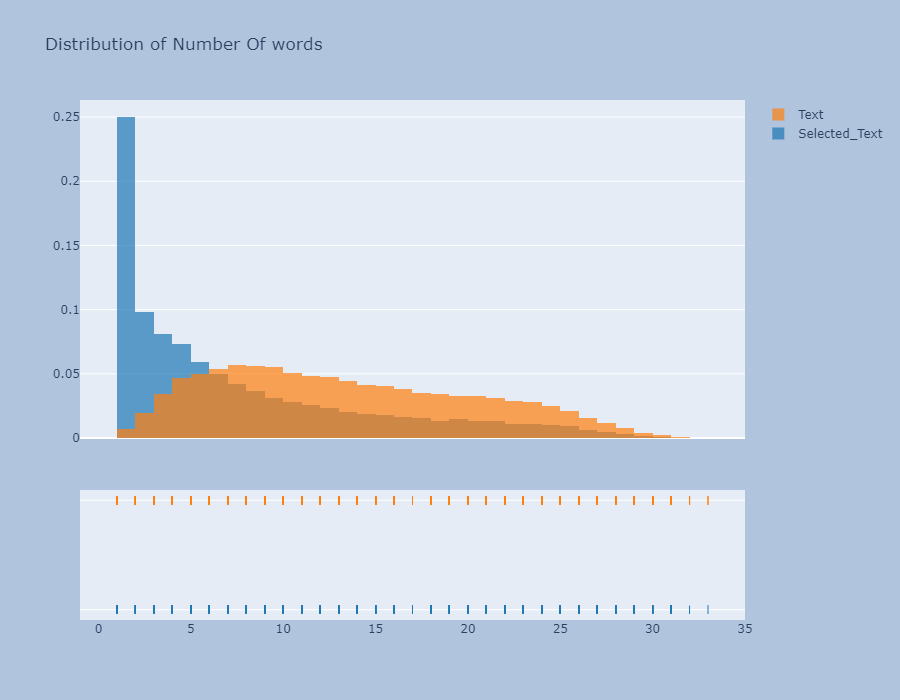
- 字数图非常有趣,字数大于 25 的推文非常少,因此字数分布图是右偏的
plt.figure(figsize=(12,6))
p1=sns.kdeplot(train['Num_words_ST'], shade=True, color="r").set_title('Kernel Distribution of Number Of words')
p1=sns.kdeplot(train['Num_word_text'], shade=True, color="b")

现在看到不同情绪的字数和jaccard分数的差异会更有趣
plt.figure(figsize=(12,6))
p1=sns.kdeplot(train[train['sentiment']=='positive']['difference_in_words'], shade=True, color="b").set_title('Kernel Distribution of Difference in Number Of words')
p2=sns.kdeplot(train[train['sentiment']=='negative']['difference_in_words'], shade=True, color="r")

plt.figure(figsize=(12,6))
sns.distplot(train[train['sentiment']=='neutral']['difference_in_words'],kde=False)

我无法绘制中性推文的 kde 图,因为大多数字数差异值为零。我们现在可以清楚地看到这一点,如果我们一开始就使用了该功能,我们就会知道对于中性推文来说,文本和所选文本大多相同,因此在执行 EDA 时牢记最终目标始终很重要
plt.figure(figsize=(12,6))
p1=sns.kdeplot(train[train['sentiment']=='positive']['jaccard_score'], shade=True, color="b").set_title('KDE of Jaccard Scores across different Sentiments')
p2=sns.kdeplot(train[train['sentiment']=='negative']['jaccard_score'], shade=True, color="r")
plt.legend(labels=['positive','negative'])
<matplotlib.legend.Legend at 0x7f99682eac50>

出于同样的原因,我无法绘制中立推文的 jaccard_scores 的 kde,因此我将绘制分布图
plt.figure(figsize=(12,6))
sns.distplot(train[train['sentiment']=='neutral']['jaccard_score'],kde=False)

我们可以在这里看到一些有趣的趋势:
- 正面和负面推文具有高峰度,因此值集中在窄和高密度两个区域
- 中性推文具有较低的峰度值,并且其密度波动接近 1
定义解释:
- 峰度是分布的峰值程度以及围绕该峰值的分布程度的度量
- 偏度衡量曲线偏离正态分布的程度
EDA结论
我们可以从 jaccard 分数图中看到,分数为 1 附近有负图和正图的峰值。这意味着存在一组推文,其中文本和所选文本之间存在高度相似性,如果我们可以找到这些聚类,那么我们可以预测这些推文的选定文本的文本,无论片段如何
让我们看看是否可以找到这些簇,一个有趣的想法是检查文本中单词数少于 3 个的推文,因为那里的文本可能完全用作文本
k = train[train['Num_word_text']<=2]
k.groupby('sentiment').mean()['jaccard_score']
sentiment
negative 0.788580
neutral 0.977805
positive 0.765700
Name: jaccard_score, dtype: float64
我们可以看到文本和所选文本之间存在相似性。让我们仔细看看
k[k['sentiment']=='positive']
因此很明显,大多数时候,文本被用作选定文本。我们可以通过预处理字长小于3的文本来改进这一点。我们将记住这些信息并在模型构建中使用它。
清理语料库
现在,在我们深入从文本和选定文本中的单词中提取信息之前,让我们首先清理数据。
def clean_text(text):'''将文本设为小写、删除方括号中的文本、删除链接、删除标点符号并删除包含数字的单词。'''text = str(text).lower()text = re.sub('\[.*?\]', '', text)text = re.sub('https?://\S+|www\.\S+', '', text)text = re.sub('<.*?>+', '', text)text = re.sub('[%s]' % re.escape(string.punctuation), '', text)text = re.sub('\n', '', text)text = re.sub('\w*\d\w*', '', text)return text
train['text'] = train['text'].apply(lambda x:clean_text(x))
train['selected_text'] = train['selected_text'].apply(lambda x:clean_text(x))
train.head()
我们的目标选定文本中最常见的单词
train['temp_list'] = train['selected_text'].apply(lambda x:str(x).split())
top = Counter([item for sublist in train['temp_list'] for item in sublist])
temp = pd.DataFrame(top.most_common(20))
temp.columns = ['Common_words','count']
temp.style.background_gradient(cmap='Blues')
| Index | Common_words | count |
|---|---|---|
| 0 | i | 7200 |
| 1 | to | 5305 |
| 2 | the | 4590 |
| 3 | a | 3538 |
| 4 | my | 2783 |
| 5 | you | 2624 |
| 6 | and | 2321 |
| 7 | it | 2158 |
| 8 | is | 2115 |
| 9 | in | 1986 |
| 10 | for | 1854 |
| 11 | im | 1676 |
| 12 | of | 1638 |
| 13 | me | 1540 |
| 14 | on | 1488 |
| 15 | so | 1410 |
| 16 | have | 1345 |
| 17 | that | 1297 |
| 18 | but | 1267 |
| 19 | good | 1251 |
fig = px.bar(temp, x="count", y="Common_words", title='Commmon Words in Selected Text', orientation='h', width=700, height=700,color='Common_words')
fig.show()
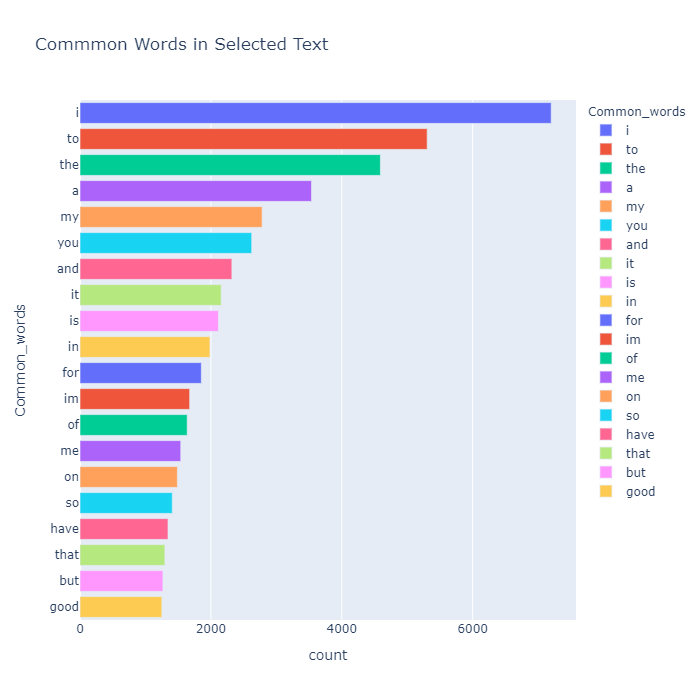
哎呀!当我们清理数据集时,我们没有删除停用词,因此我们可以看到最常见的词是 ‘to’ 。删除停用词后重试
def remove_stopword(x):return [y for y in x if y not in stopwords.words('english')]
train['temp_list'] = train['temp_list'].apply(lambda x:remove_stopword(x))
top = Counter([item for sublist in train['temp_list'] for item in sublist])
temp = pd.DataFrame(top.most_common(20))
temp = temp.iloc[1:,:]
temp.columns = ['Common_words','count']
temp.style.background_gradient(cmap='Purples')
| Index | Common_words | count |
|---|---|---|
| 1 | good | 1251 |
| 2 | day | 1058 |
| 3 | love | 909 |
| 4 | happy | 852 |
| 5 | like | 774 |
| 6 | get | 772 |
| 7 | dont | 765 |
| 8 | go | 700 |
| 9 | cant | 613 |
| 10 | work | 612 |
| 11 | going | 592 |
| 12 | today | 564 |
| 13 | got | 558 |
| 14 | one | 538 |
| 15 | time | 534 |
| 16 | thanks | 532 |
| 17 | lol | 528 |
| 18 | really | 520 |
| 19 | u | 519 |
fig = px.treemap(temp, path=['Common_words'], values='count',title='Tree of Most Common Words')
fig.show()
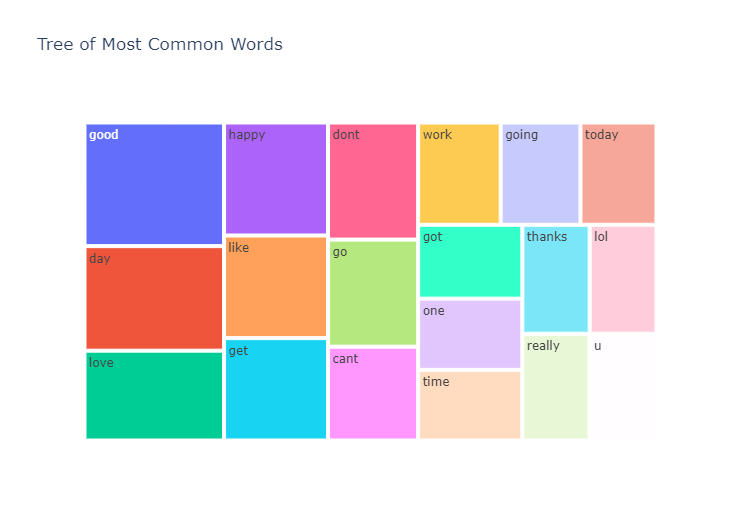
文本中最常见的单词
我们还看一下 Text 中最常见的单词
train['temp_list1'] = train['text'].apply(lambda x:str(x).split()) #文本每行的单词列表
train['temp_list1'] = train['temp_list1'].apply(lambda x:remove_stopword(x)) #删除停用词
top = Counter([item for sublist in train['temp_list1'] for item in sublist])
temp = pd.DataFrame(top.most_common(25))
temp = temp.iloc[1:,:]
temp.columns = ['Common_words','count']
temp.style.background_gradient(cmap='Blues')
| Index | Common_words | count |
|---|---|---|
| 1 | day | 2044 |
| 2 | good | 1549 |
| 3 | get | 1426 |
| 4 | like | 1346 |
| 5 | go | 1267 |
| 6 | dont | 1200 |
| 7 | love | 1122 |
| 8 | work | 1112 |
| 9 | going | 1096 |
| 10 | today | 1096 |
| 11 | got | 1072 |
| 12 | cant | 1020 |
| 13 | happy | 976 |
| 14 | one | 971 |
| 15 | lol | 948 |
| 16 | time | 942 |
| 17 | know | 930 |
| 18 | u | 923 |
| 19 | really | 908 |
| 20 | back | 891 |
| 21 | see | 797 |
| 22 | well | 744 |
| 23 | new | 740 |
| 24 | night | 737 |
所以前两个常见词是我,所以我删除了它并从第二行获取数据
fig = px.bar(temp, x="count", y="Common_words", title='Commmon Words in Text', orientation='h', width=700, height=700,color='Common_words')
fig.show()
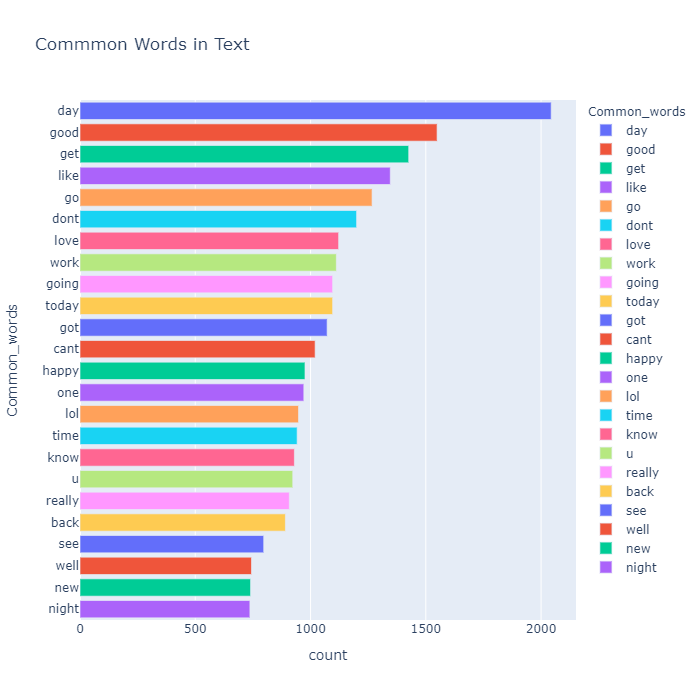
所以我们可以看到所选文本和文本中最常见的单词几乎相同,这是显而易见的
最常用的词 情感明智
让我们看看不同情绪中最常见的单词
Positive_sent = train[train['sentiment']=='positive']
Negative_sent = train[train['sentiment']=='negative']
Neutral_sent = train[train['sentiment']=='neutral']
#最常见的正面词汇
top = Counter([item for sublist in Positive_sent['temp_list'] for item in sublist])
temp_positive = pd.DataFrame(top.most_common(20))
temp_positive.columns = ['Common_words','count']
temp_positive.style.background_gradient(cmap='Greens')
| Index | Common_words | count |
|---|---|---|
| 0 | good | 826 |
| 1 | happy | 730 |
| 2 | love | 697 |
| 3 | day | 456 |
| 4 | thanks | 439 |
| 5 | great | 364 |
| 6 | fun | 287 |
| 7 | nice | 267 |
| 8 | mothers | 259 |
| 9 | hope | 245 |
| 10 | awesome | 232 |
| 11 | im | 185 |
| 12 | thank | 180 |
| 13 | like | 167 |
| 14 | best | 154 |
| 15 | wish | 152 |
| 16 | amazing | 135 |
| 17 | really | 128 |
| 18 | better | 125 |
| 19 | cool | 119 |
fig = px.bar(temp_positive, x="count", y="Common_words", title='Most Commmon Positive Words', orientation='h', width=700, height=700,color='Common_words')
fig.show()
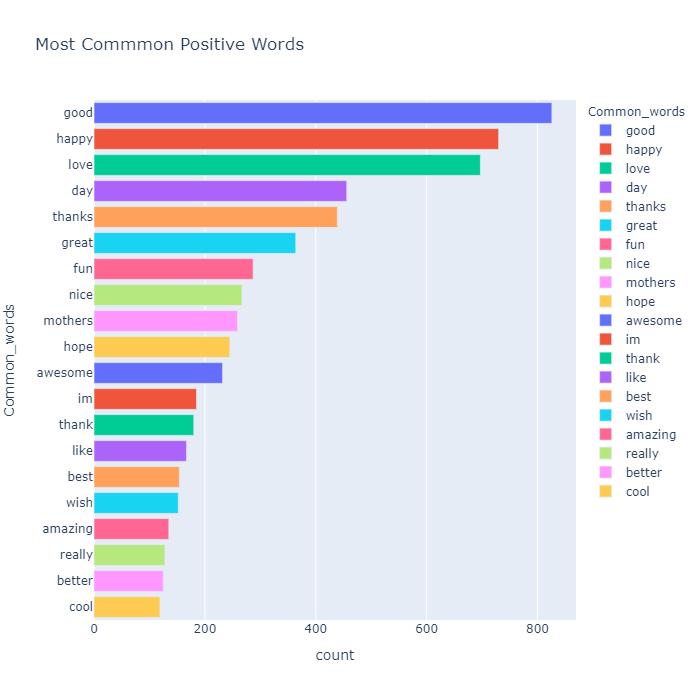
#最常见的负面词
top = Counter([item for sublist in Negative_sent['temp_list'] for item in sublist])
temp_negative = pd.DataFrame(top.most_common(20))
temp_negative = temp_negative.iloc[1:,:]
temp_negative.columns = ['Common_words','count']
temp_negative.style.background_gradient(cmap='Reds')
| Index | Common_words | count |
|---|---|---|
| 1 | miss | 358 |
| 2 | sad | 343 |
| 3 | sorry | 300 |
| 4 | bad | 246 |
| 5 | hate | 230 |
| 6 | dont | 221 |
| 7 | cant | 201 |
| 8 | sick | 166 |
| 9 | like | 162 |
| 10 | sucks | 159 |
| 11 | feel | 158 |
| 12 | tired | 144 |
| 13 | really | 137 |
| 14 | good | 127 |
| 15 | bored | 115 |
| 16 | day | 110 |
| 17 | hurts | 108 |
| 18 | work | 99 |
| 19 | get | 97 |
fig = px.treemap(temp_negative, path=['Common_words'], values='count',title='Tree Of Most Common Negative Words')
fig.show()

#最常见的中性词
top = Counter([item for sublist in Neutral_sent['temp_list'] for item in sublist])
temp_neutral = pd.DataFrame(top.most_common(20))
temp_neutral = temp_neutral.loc[1:,:]
temp_neutral.columns = ['Common_words','count']
temp_neutral.style.background_gradient(cmap='Reds')
| Index | Common_words | count |
|---|---|---|
| 1 | get | 612 |
| 2 | go | 569 |
| 3 | day | 492 |
| 4 | dont | 482 |
| 5 | going | 472 |
| 6 | work | 467 |
| 7 | like | 445 |
| 8 | got | 441 |
| 9 | today | 427 |
| 10 | lol | 427 |
| 11 | time | 413 |
| 12 | know | 407 |
| 13 | back | 402 |
| 14 | one | 394 |
| 15 | u | 376 |
| 16 | see | 349 |
| 17 | cant | 339 |
| 18 | home | 335 |
| 19 | want | 319 |
fig = px.bar(temp_neutral, x="count", y="Common_words", title='Most Commmon Neutral Words', orientation='h', width=700, height=700,color='Common_words')
fig.show()
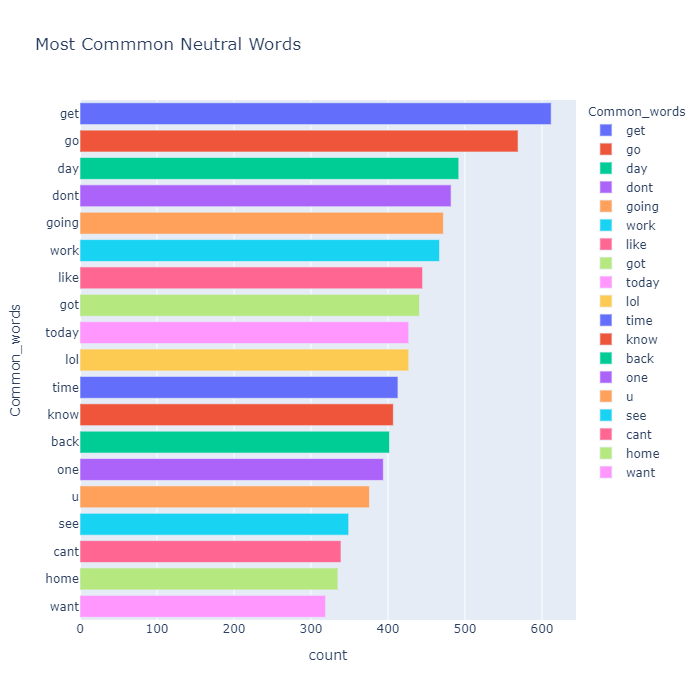
fig = px.treemap(temp_neutral, path=['Common_words'], values='count',title='Tree Of Most Common Neutral Words')
fig.show()
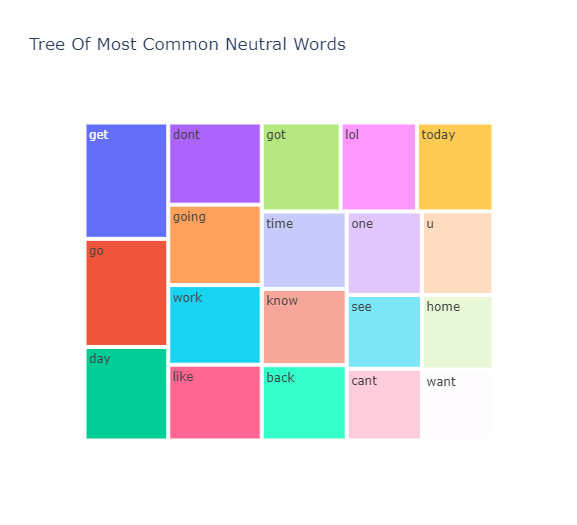
我们可以看到 get、go、dont、got、u、cant、lol、like 等词在这三个细分市场中都很常见。这很有趣,因为像 dont 和 cant 这样的词更多的是消极的性质,而像 lol 这样的词更多的是积极的性质。这是否意味着我们的数据被错误地标记了,在 N-gram 分析后我们将对此有更多的见解
看到不同情绪所特有的词会很有趣
让我们看看每个片段中的独特单词
我们将按以下顺序查看每个片段中的唯一单词:
- 积极的
- 消极的
- 中性的
raw_text = [word for word_list in train['temp_list1'] for word in word_list]
def words_unique(sentiment,numwords,raw_words):'''输入:细分 -细分类别(例如“中性”);numwords -您希望在最终结果中看到多少个特定单词; raw_words -train_data[train_data.segments == snippets]['temp_list1'] 中的项目列表:输出: 数据框提供有关特定成分名称及其在所选菜肴中出现的次数的信息(根据其计数按降序排列)..'''allother = []for item in train[train.sentiment != sentiment]['temp_list1']:for word in item:allother .append(word)allother = list(set(allother ))specificnonly = [x for x in raw_text if x not in allother]mycounter = Counter()for item in train[train.sentiment == sentiment]['temp_list1']:for word in item:mycounter[word] += 1keep = list(specificnonly)for word in list(mycounter):if word not in keep:del mycounter[word]Unique_words = pd.DataFrame(mycounter.most_common(numwords), columns = ['words','count'])return Unique_words
积极的推文
Unique_Positive= words_unique('positive', 20, raw_text)
print("The top 20 unique words in Positive Tweets are:")
Unique_Positive.style.background_gradient(cmap='Greens')
The top 20 unique words in Positive Tweets are:
| Index | words | count |
|---|---|---|
| 0 | congratulations | 29 |
| 1 | thnx | 10 |
| 2 | appreciated | 8 |
| 3 | shared | 7 |
| 4 | presents | 7 |
| 5 | greetings | 7 |
| 6 | blessings | 6 |
| 7 | mothersday | 6 |
| 8 | mcr | 6 |
| 9 | coolest | 6 |
| 10 | honored | 6 |
| 11 | goood | 6 |
| 12 | wango | 5 |
| 13 | actress | 5 |
| 14 | mint | 5 |
| 15 | dayyyy | 5 |
| 16 | ciara | 5 |
| 17 | twin | 5 |
| 18 | kudos | 5 |
| 19 | hurray | 5 |
fig = px.treemap(Unique_Positive, path=['words'], values='count',title='Tree Of Unique Positive Words')
fig.show()
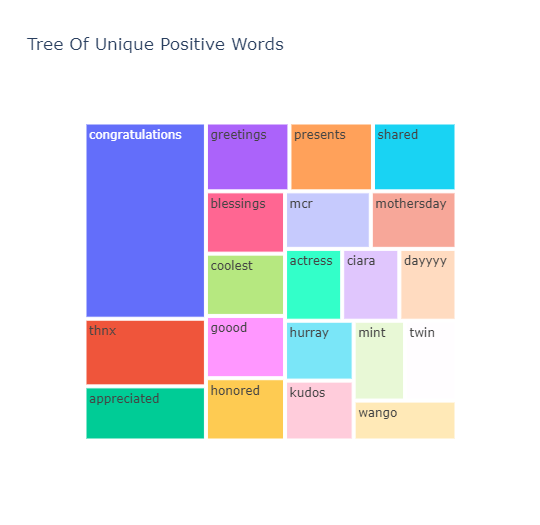
from palettable.colorbrewer.qualitative import Pastel1_7
plt.figure(figsize=(16,10))
my_circle=plt.Circle((0,0), 0.7, color='white')
plt.pie(Unique_Positive['count'], labels=Unique_Positive.words, colors=Pastel1_7.hex_colors)
p=plt.gcf()
p.gca().add_artist(my_circle)
plt.title('DoNut Plot Of Unique Positive Words')
plt.show()
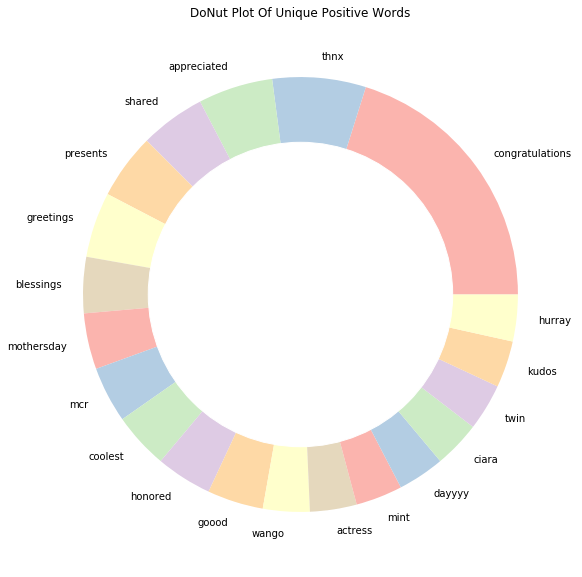
Unique_Negative= words_unique('negative', 10, raw_text)
print("The top 10 unique words in Negative Tweets are:")
Unique_Negative.style.background_gradient(cmap='Reds')
The top 10 unique words in Negative Tweets are:
| Index | words | count |
|---|---|---|
| 0 | ache | 12 |
| 1 | suffering | 9 |
| 2 | allergic | 7 |
| 3 | cramps | 7 |
| 4 | saddest | 7 |
| 5 | pissing | 7 |
| 6 | sob | 6 |
| 7 | dealing | 6 |
| 8 | devastated | 6 |
| 9 | noes | 6 |
from palettable.colorbrewer.qualitative import Pastel1_7
plt.figure(figsize=(16,10))
my_circle=plt.Circle((0,0), 0.7, color='white')
plt.rcParams['text.color'] = 'black'
plt.pie(Unique_Negative['count'], labels=Unique_Negative.words, colors=Pastel1_7.hex_colors)
p=plt.gcf()
p.gca().add_artist(my_circle)
plt.title('DoNut Plot Of Unique Negative Words')
plt.show()
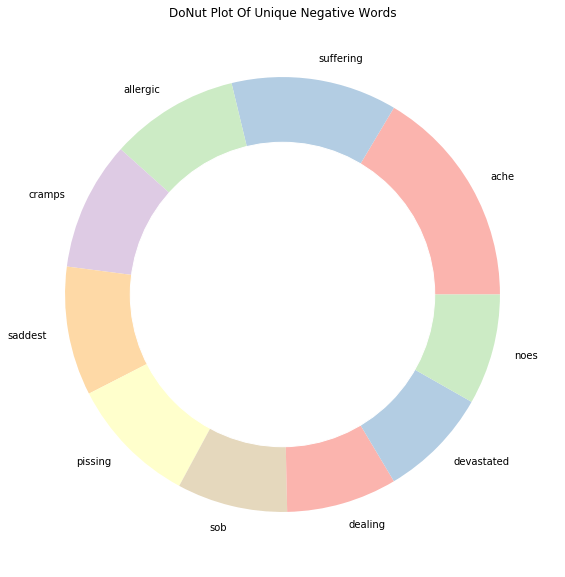
Unique_Neutral= words_unique('neutral', 10, raw_text)
print("The top 10 unique words in Neutral Tweets are:")
Unique_Neutral.style.background_gradient(cmap='Oranges')
The top 10 unique words in Neutral Tweets are:
| Index | words | count |
|---|---|---|
| 0 | settings | 9 |
| 1 | explain | 7 |
| 2 | mite | 6 |
| 3 | hiya | 6 |
| 4 | reader | 5 |
| 5 | pr | 5 |
| 6 | sorta | 5 |
| 7 | fathers | 5 |
| 8 | enterprise | 5 |
| 9 | guessed | 5 |
from palettable.colorbrewer.qualitative import Pastel1_7
plt.figure(figsize=(16,10))
my_circle=plt.Circle((0,0), 0.7, color='white')
plt.pie(Unique_Neutral['count'], labels=Unique_Neutral.words, colors=Pastel1_7.hex_colors)
p=plt.gcf()
p.gca().add_artist(my_circle)
plt.title('DoNut Plot Of Unique Neutral Words')
plt.show()
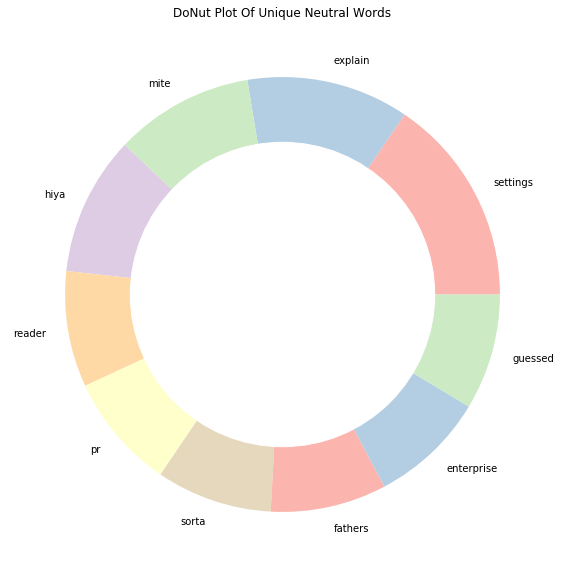
通过查看每种情绪的独特单词,我们现在对数据有了更清晰的了解,这些独特的单词是推文情绪的强有力决定因素
词云图绘制
我们将按以下顺序构建词云:
- 中性推文的词云
- 积极推文的词云
- 负面推文的词云
def plot_wordcloud(text, mask=None, max_words=200, max_font_size=100, figure_size=(24.0,16.0), color = 'white',title = None, title_size=40, image_color=False):stopwords = set(STOPWORDS)more_stopwords = {'u', "im"}stopwords = stopwords.union(more_stopwords)wordcloud = WordCloud(background_color=color,stopwords = stopwords,max_words = max_words,max_font_size = max_font_size, random_state = 42,width=400, height=200,mask = mask)wordcloud.generate(str(text))plt.figure(figsize=figure_size)if image_color:image_colors = ImageColorGenerator(mask);plt.imshow(wordcloud.recolor(color_func=image_colors), interpolation="bilinear");plt.title(title, fontdict={'size': title_size, 'verticalalignment': 'bottom'})else:plt.imshow(wordcloud);plt.title(title, fontdict={'size': title_size, 'color': 'black', 'verticalalignment': 'bottom'})plt.axis('off');plt.tight_layout()
d = '/kaggle/input/masks-for-wordclouds/'
我添加了更多单词,如 im 、 u (我们说这些单词出现在最常见的单词中,干扰了我们的分析)作为停用词
中性推文云
我们已经形象化了最常见的否定词,但词云为我们提供了更多的清晰度
pos_mask = np.array(Image.open(d+ 'twitter_mask.png'))
plot_wordcloud(Neutral_sent.text,mask=pos_mask,color='white',max_font_size=100,title_size=30,title="WordCloud of Neutral Tweets")
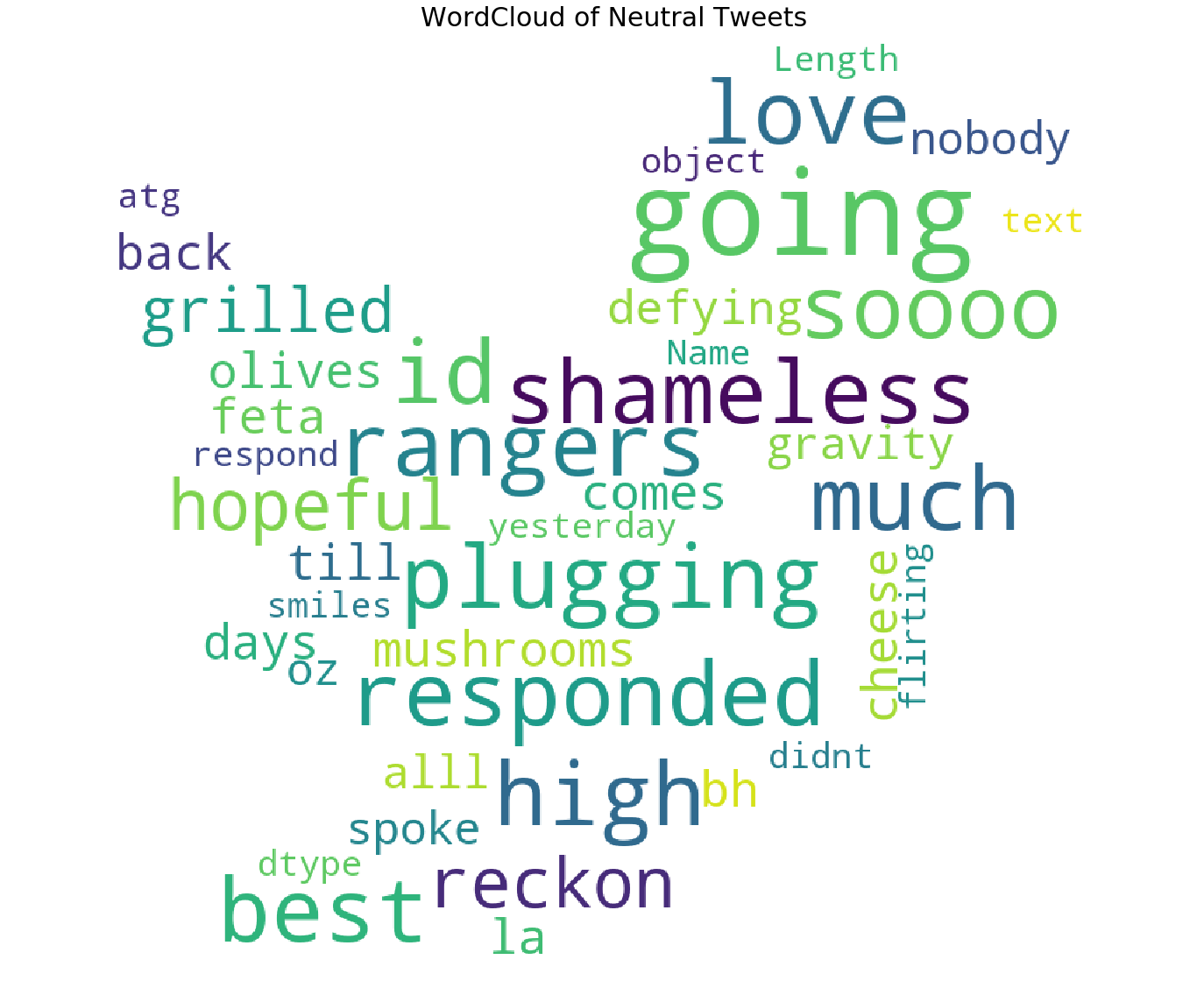
plot_wordcloud(Positive_sent.text,mask=pos_mask,title="Word Cloud Of Positive tweets",title_size=30)

plot_wordcloud(Negative_sent.text,mask=pos_mask,title="Word Cloud of Negative Tweets",color='white',title_size=30)
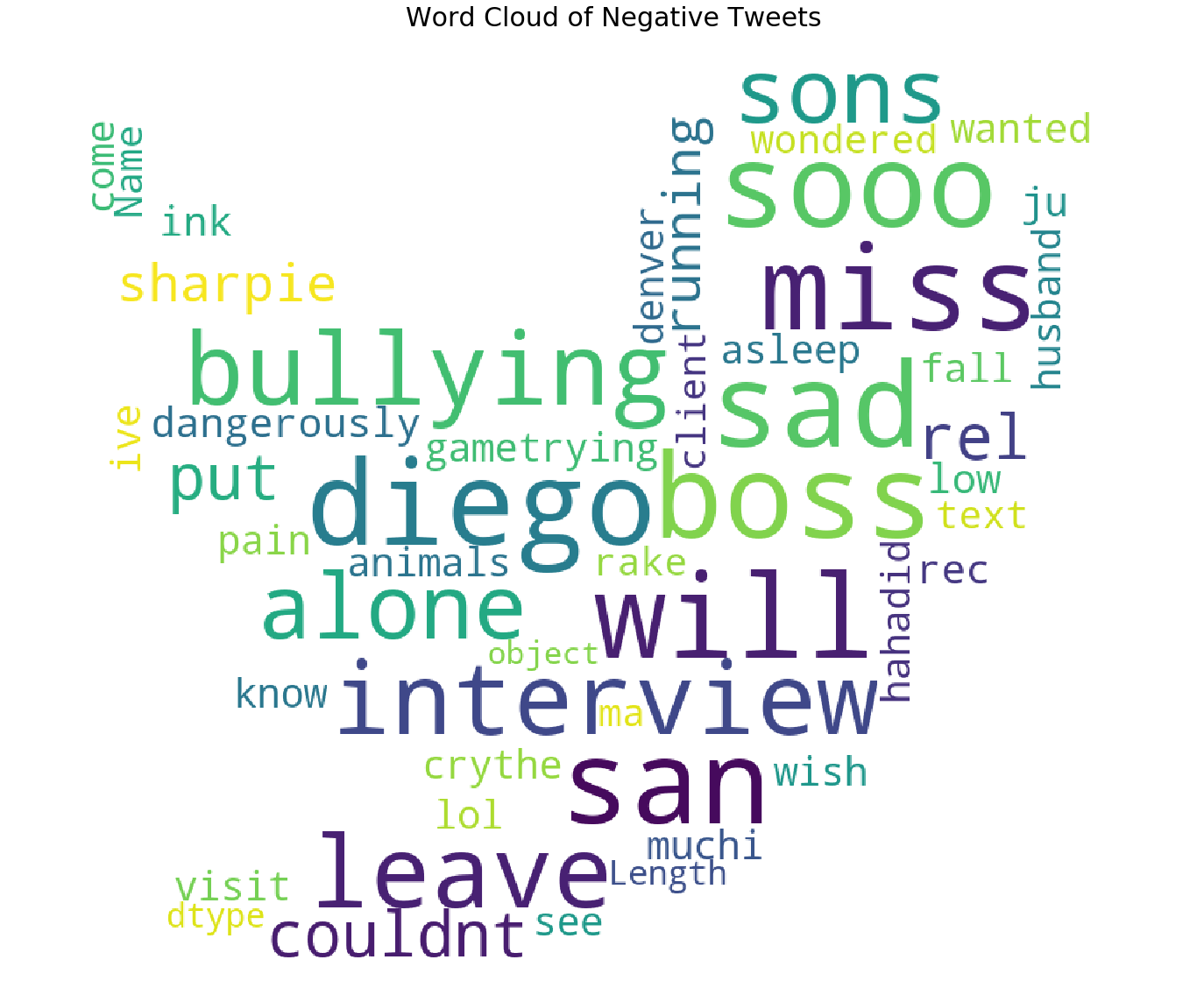
模型构建
1) 将问题建模为 NER
命名实体识别 (NER) 是一个标准的 NLP 问题,涉及从文本块中识别命名实体(人物、地点、组织等),并将它们分类为一组预定义的类别。
为了理解 NER,这里有一篇非常好的文章:https://towardsdatascience.com/named-entity-recognition-with-nltk-and-spacy-8c4a7d88e7da
我们将使用 spacy 来创建我们自己的定制 NER 模型(针对每个情绪单独)。这种方法的动机当然是 Rohit Singh 共享的内核。
我的解决方案有何不同:
- 由于 jaccard 的高度相似性,我将使用文本作为所有中性推文的 selected_text
- 此外,我还将使用文本作为文本中字数少于 3 个的所有推文的 selected_text,如前所述
- 我将为正面和负面推文训练两种不同的模型
- 我不会预处理数据,因为所选文本包含原始文本
df_train = pd.read_csv('/kaggle/input/tweet-sentiment-extraction/train.csv')
df_test = pd.read_csv('/kaggle/input/tweet-sentiment-extraction/test.csv')
df_submission = pd.read_csv('/kaggle/input/tweet-sentiment-extraction/sample_submission.csv')
df_train['Num_words_text'] = df_train['text'].apply(lambda x:len(str(x).split())) #训练集中正文中的字数
df_train = df_train[df_train['Num_words_text']>=3]
要完全了解如何使用自定义输入训练 spacy NER,请阅读 spacy 文档以及本笔记本中的代码演示:https://spacy.io/usage/training#ner 按照更新 Spacy NER
def save_model(output_dir, nlp, new_model_name):''' This Function Saves model to given output directory'''output_dir = f'../working/{output_dir}'if output_dir is not None: if not os.path.exists(output_dir):os.makedirs(output_dir)nlp.meta["name"] = new_model_namenlp.to_disk(output_dir)print("Saved model to", output_dir)
# 如果你想在现有模型上进行训练,请传递 model = nlpdef train(train_data, output_dir, n_iter=20, model=None):"""Load the model, set up the pipeline and train the entity recognizer."""""if model is not None:nlp = spacy.load(output_dir) # load existing spaCy modelprint("Loaded model '%s'" % model)else:nlp = spacy.blank("en") # create blank Language classprint("Created blank 'en' model")# 创建内置管道组件并将其添加到管道中# nlp.create_pipe 适用于在 spaCy 中注册的内置程序if "ner" not in nlp.pipe_names:ner = nlp.create_pipe("ner")nlp.add_pipe(ner, last=True)# 否则,获取它以便我们添加标签else:ner = nlp.get_pipe("ner")# 添加标签for _, annotations in train_data:for ent in annotations.get("entities"):ner.add_label(ent[2])# 获取其他管道的名称以在训练期间禁用它们other_pipes = [pipe for pipe in nlp.pipe_names if pipe != "ner"]with nlp.disable_pipes(*other_pipes): # only train NER# sizes = compounding(1.0, 4.0, 1.001)# batch up the examples using spaCy's minibatchif model is None:nlp.begin_training()else:nlp.resume_training()for itn in tqdm(range(n_iter)):random.shuffle(train_data)batches = minibatch(train_data, size=compounding(4.0, 500.0, 1.001)) losses = {}for batch in batches:texts, annotations = zip(*batch)nlp.update(texts, # batch of textsannotations, # batch of annotationsdrop=0.5, # dropout - make it harder to memorise datalosses=losses, )print("Losses", losses)save_model(output_dir, nlp, 'st_ner')
def get_model_out_path(sentiment):'''Returns Model output path'''model_out_path = Noneif sentiment == 'positive':model_out_path = 'models/model_pos'elif sentiment == 'negative':model_out_path = 'models/model_neg'return model_out_path
def get_training_data(sentiment):'''Returns Trainong data in the format needed to train spacy NER'''train_data = []for index, row in df_train.iterrows():if row.sentiment == sentiment:selected_text = row.selected_texttext = row.textstart = text.find(selected_text)end = start + len(selected_text)train_data.append((text, {"entities": [[start, end, 'selected_text']]}))return train_data
正面和负面推文的训练模型
sentiment = 'positive'train_data = get_training_data(sentiment)
model_path = get_model_out_path(sentiment)
# 出于演示目的,我进行了 3 次迭代,您可以根据需要训练模型
train(train_data, model_path, n_iter=3, model=None)
Created blank 'en' model33%|███▎ | 1/3 [00:52<01:45, 52.84s/it]Losses {'ner': 33900.41114743876}67%|██████▋ | 2/3 [01:45<00:52, 52.68s/it]Losses {'ner': 30517.31436416012}100%|██████████| 3/3 [02:37<00:00, 52.62s/it]Losses {'ner': 28912.80112953766}
Saved model to ../working/models/model_pos
sentiment = 'negative'train_data = get_training_data(sentiment)
model_path = get_model_out_path(sentiment)train(train_data, model_path, n_iter=3, model=None)
0%| | 0/3 [00:00<?, ?it/s]Created blank 'en' model33%|███▎ | 1/3 [00:50<01:41, 50.56s/it]Losses {'ner': 31926.559298905544}67%|██████▋ | 2/3 [01:40<00:50, 50.32s/it]Losses {'ner': 28526.67285699508}100%|██████████| 3/3 [02:30<00:00, 50.02s/it]Losses {'ner': 27071.952286979005}
Saved model to ../working/models/model_neg
使用经过训练的模型进行预测
def predict_entities(text, model):doc = model(text)ent_array = []for ent in doc.ents:start = text.find(ent.text)end = start + len(ent.text)new_int = [start, end, ent.label_]if new_int not in ent_array:ent_array.append([start, end, ent.label_])selected_text = text[ent_array[0][0]: ent_array[0][1]] if len(ent_array) > 0 else textreturn selected_text
selected_texts = []
MODELS_BASE_PATH = '../input/tse-spacy-model/models/'if MODELS_BASE_PATH is not None:print("Loading Models from ", MODELS_BASE_PATH)model_pos = spacy.load(MODELS_BASE_PATH + 'model_pos')model_neg = spacy.load(MODELS_BASE_PATH + 'model_neg')for index, row in df_test.iterrows():text = row.textoutput_str = ""if row.sentiment == 'neutral' or len(text.split()) <= 2:selected_texts.append(text)elif row.sentiment == 'positive':selected_texts.append(predict_entities(text, model_pos))else:selected_texts.append(predict_entities(text, model_neg))df_test['selected_text'] = selected_texts
Loading Models from ../input/tse-spacy-model/models/
df_submission['selected_text'] = df_test['selected_text']
df_submission.to_csv("submission.csv", index=False)
display(df_submission.head(10))
| Index | textID | selected_text |
|---|---|---|
| 0 | f87dea47db | Last session of the day http://twitpic.com/67ezh |
| 1 | 96d74cb729 | exciting |
| 2 | eee518ae67 | Recession |
| 3 | 01082688c6 | happy bday! |
| 4 | 33987a8ee5 | I like it!! |
| 5 | 726e501993 | visitors! |
| 6 | 261932614e | HATES |
| 7 | afa11da83f | blocked |
| 8 | e64208b4ef | and within a short time of the last clue all… |
| 9 | 37bcad24ca | What did you get? My day is alright… haven’t… |
相关文章:

经典NLP案例 | 推文评论情绪分析:从数据预处理到模型构建的全面指南
NLP经典案例:推文评论情绪提取 项目背景 “My ridiculous dog is amazing.” [sentiment: positive] 由于所有推文每秒都在传播,很难判断特定推文背后的情绪是否会影响一家公司或一个人的品牌,因为它的病毒式传播(积极࿰…...

蓝卓生态说 | 捷创技术李恺和:把精细管理和精益生产做到极致
成功的产品离不开开放式创新和生态协同的力量。近年来,蓝卓坚持“平台生态"战略,不断加码生态,提出三个层次的开源开放生态计划,举办"春风行动”、“生态沙龙"等系列活动,与生态伙伴共生、共创、共同推…...

启发式搜索算法和优化算法的区别
启发式搜索算法和优化算法在计算机科学中都有广泛的应用,但它们之间存在一些明显的区别。 一、定义与核心思想 启发式搜索算法 定义:启发式搜索算法是一类基于经验和直觉的问题求解方法,通过观察问题的特点,并根据某种指…...

生成树协议STP工作步骤
第一步:选择根桥 优先级比较:首先比较优先级,优先级值越小的是根桥MAC地址比较:如果优先级相同,则比较MAC地址。MAC地址小的是根桥。 MAC地址比较的时候从左往右,一位一位去比 第二步:所有非根…...

批量合并多个Excel到一个文件
工作中,我们经常需要将多个Excel的数据进行合并,很多插件都可以做这个功能。但是今天我们将介绍一个完全免费的独立软件【非插件】,来更加方便的实现这个功能。 准备Excel 这里我们准备了两张待合并的Excel文件 的卢易表 打开的卢易表软件…...

如何在vue中实现父子通信
1.需要用到的组件 父组件 <template><div id"app"><BaseCount :count"count" changeCount"cahngeCount"></BaseCount></div> </template><script> import BaseCount from ./components/BaseCount.v…...

强化学习Q-learning及其在机器人路径规划系统中的应用研究,matlab代码
一、Q-learning 算法概述 Q-learning 是一种无模型的强化学习算法,它允许智能体(agent)在没有环境模型的情况下通过与环境的交互来学习最优策略。Q-learning的核心是学习一个动作价值函数(Q-function),该函…...

【算法】EWMA指数加权移动平均绘制平滑曲线
EWMA(Exponentially Weighted Moving Average,指数加权移动平均)是一种常用的时间序列平滑技术,特别适用于对过去数据给予不同的权重。以下是对EWMA算法的详细介绍: 一、核心思想 EWMA算法的核心思想是通过指数衰减来…...

jenkins harbor安装
Harbor是一个企业级Docker镜像仓库。 文章目录 1. 什么是Docker私有仓库2. Docker有哪些私有仓库3. Harbor简介4. Harbor安装 1. 什么是Docker私有仓库 Docker私有仓库是用于存储和管理Docker镜像的私有存储库。Docker默认会有一个公共的仓库Docker Hub,而与Dock…...
——节点参数配置化)
行为树详解(4)——节点参数配置化
【分析】 行为树是否足够灵活强大依赖于足够丰富的各类条件节点和动作节点,在实现这些节点时,不可避免的,节点本身需要有一些参数供配置。 这些参数可以分为静态的固定值的参数以及动态读取设置的参数。 静态参数直接设置为Public即可&…...

在数字孪生开发领域threejs现在的最新版本已经更新到多少了?
在数字孪生开发领域three.js现在的最新版本已经更新到多少了? 在数字孪生开发领域,three.js作为一款强大的JavaScript 3D库,广泛应用于Web3D可视化、智慧城市、智慧园区、数字孪生等多个领域。随着技术的不断进步和需求的日益增长࿰…...

UE材质常用节点
Desaturation 去色 饱和度控制 Panner 贴图流动 快捷键P Append 附加 合并 TexCoord UV平铺大小 快捷键U CustomRotator 旋转贴图 Power 幂 色阶 Mask 遮罩 Lerp 线性插值 快捷键L Abs 绝对值 Sin / Cos 正弦/余弦 Saturate 约束在0-1之间 Add 相加 快捷键A Subtra…...
利用java安装burpsuite)
burp(2)利用java安装burpsuite
BurpSuite安装 burpsuite 2024.10专业版,已经内置java环境,可以直接使用, 支持Windows linux macOS!!! 内置jre环境,无需安装java即可使用!!! bp2024.10下载…...

33.攻防世界upload1
进入场景 看看让上传什么类型的文件 传个木马 把txt后缀改为png 在bp里把png改为php 上传成功 用蚁剑连接 在里面找flag 得到...

17、ConvMixer模型原理及其PyTorch逐行实现
文章目录 1. 重点2. 思维导图 1. 重点 patch embedding : 将图形分割成不重叠的块作为图片样本特征depth wise point wise new conv2d : 将传统的卷积转换成通道隔离卷积和像素空间隔离两个部分,在保证精度下降不多的情况下大大减少参数量 2. 思维导图 后续再整…...
)
【软件工程】一篇入门UML建模图(状态图、活动图、构件图、部署图)
🌈 个人主页:十二月的猫-CSDN博客 🔥 系列专栏: 🏀软件开发必练内功_十二月的猫的博客-CSDN博客 💪🏻 十二月的寒冬阻挡不了春天的脚步,十二点的黑夜遮蔽不住黎明的曙光 目录 1. 前…...

C# winfrom 异步加载数据不影响窗体UI
文章目录 前言一、背景介绍二、使用BackgroundWorker组件实现异步加载数据2.1 添加BackgroundWorker组件2.2 处理DoWork事件 三、延伸内容3.1 错误处理和进度报告3.2 线程安全 结束语优质源码分享 C# winfrom 异步加载数据不影响窗体UI,在 WinForms 应用程序中&…...

Flutter Navigator2.0的原理和Web端实践
01 背景与动机 在Navigator 2.0推出之前,Flutter主要通过Navigator 1.0和其提供的 API(如push(), pop(), pushNamed()等)来管理页面路由。然而,Navigator 1.0存在一些局限性,如难以实现复杂的页面操作(如移…...

latex设置引用顺序
在 LaTeX 中,引用的顺序通常是由所选择的 参考文献样式(bibliographystyle) 决定的。如果你希望根据引用的顺序排列参考文献,可以选择合适的参考文献样式,并按照以下步骤进行设置。 常见的几种引用顺序设置方式有&…...
)
有效的括号(字节面试题 最优解)
题目来源 20. 有效的括号 - 力扣(LeetCode) 题目描述 给定一个只包括 (,),{,},[,] 的字符串 s ,判断字符串是否有效。 有效字符串需满足: 左括号必须用相同类型的右括号…...

短视频矩阵源码开发部署全流程解析
在当今的数字化时代,短视频已成为人们娱乐、学习和社交的重要方式。短视频矩阵系统的开发与部署,对于希望在这一领域脱颖而出的企业和个人而言,至关重要。本文将详细阐述短视频矩阵源码的开发与部署流程,并附上部分源代码示例&…...

iOS 环境搭建教程
本文档将详细介绍如何在 macOS 上搭建 iOS 开发环境,以便进行 React Native 开发。(为了保证环境一致 全部在网络通畅的情况下运行) 1. 安装 Homebrew Homebrew 是 macOS 的包管理工具,我们将通过它来安装开发所需的工具。 安装…...
功能实现)
element-ui实现table表格的嵌套(table表格嵌套)功能实现
最近在做电商类型的官网,希望实现的布局如下:有表头和表身,所以我首先想到的就是table表格组件。 表格组件中常见的就是:标题和内容一一对应: 像效果图中的效果,只用基础的表格布局是不行的,因…...

如何使mysql数据库ID从0开始编号——以BiCorpus为例
BiCorpus是北京语言大学韩林涛老师研制一款在线语料库网站,可以通过上传tmx文件,实现在线检索功能,程序在github上开源免费,深受广大网友的喜欢。 在使用过程中,我发现我上传的语言资产经历修改后,mysql的…...
亮相AICon,火山引擎边缘云揭秘边缘AI Agent探索与实践
12月13-14日,AICon 全球人工智能开发与应用大会在北京成功举办。火山引擎边缘智能技术负责人谢皓受邀出席大会,以《AI Agent 在边缘云的探索与实践》为主题,与全球 AI 领域的资深专家,共同深入探讨大模型落地、具身智能、多模态大…...

让文案生成更具灵活性/chatGPT新功能canvas画布编辑
OpenAI最近在2024年12月发布了canvas画布编辑功能,这是一项用途广泛的创新工具,专为需要高效创作文案的用户设计。 无论是职场人士、学生还是创作者,这项功能都能帮助快速生成、优化和编辑文案,提升效率的同时提高内容质量…...

朗致面试---IOS/安卓/Java/架构师
朗致面试---IOS/安卓/Java/架构师 一、面试概况二、总结三、算法题目参考答案 一、面试概况 一共三轮面试: 第一轮是逻辑行测,25道题目,类似于公务员考试题目,要求90分钟内完成。第二轮是技术面试,主要是做一些数据结…...

windows C#-实现具有自动实现属性的轻型类
下面演示如何创建一个不可变的轻型类,该类仅用于封装一组自动实现的属性。 当你必须使用引用类型语义时,请使用此种构造而不是结构。 可通过以下方法来实现不可变的属性: 仅声明 get 访问器,使属性除了能在该类型的构造函数中可…...

深度学习之Autoencoders GANs for Anomaly Detection 视频异常检测
在视频异常检测(Video Anomaly Detection)任务中,Autoencoders(自编码器) 和 GANs(生成对抗网络) 是常用的深度学习模型,它们在检测视频中的异常事件(如入侵、破坏、非法行为等)方面发挥着重要作用。通过分析视频帧的时空特征,这些模型能够识别出与正常行为模式不同…...
检测到下降沿)
实现按键按下(低电平)检测到下降沿
按照流程进行编程 步骤1: 初始化函数 包括时基工作参数配置 输入通道配置 更新中断使能 使能捕获、捕获中断及计数器 HAL_TIM_IC_Init(&ic_handle) //时基参数配置 HAL_TIM_IC_ConfigChannel(&ic_handle,&ic_config,TIM_CHANNEL_2) //输…...

【21天学习AI底层概念】day5 机器学习的三大类型不能解决哪些问题?
机器学习的三大类型——监督学习、无监督学习和强化学习,虽然可以应用于许多问题,但并非所有问题都能通过这些方法有效解决。每种类型的机器学习都有其局限性,具体如下: 1. 监督学习 (Supervised Learning) 监督学习是通过训练数…...
)
八股—Java基础(一)
目录 一、Java概述 1、Java语言有哪些特点? 2、JVM、JDK、JRE有什么区别? 3、什么是跨平台性?原理是什么 4、Java和C有什么关系,它们有什么区别? 5、JVM、JRE和JDK的关系是什么? 6、什么是字节码? …...

PWM调节DCDC参数计算原理
1、动态电压频率调整DVFS SOC芯片的核电压、GPU电压、NPU电压、GPU电压等,都会根据性能和实际应用场景来进行电压和频率的调整。 即动态电压频率调整DVFS(Dynamic Voltage and Frequency scaling),优化性能和功耗。 比如某SOC在…...

设计一个基础JWT的多开发语言分布式电商系统
在设计一个分布式电商系统时,保证系统的可扩展性、性能以及跨语言的兼容性是至关重要的。随着微服务架构的流行,越来越多的电商系统需要在多个服务间共享信息,并且保证服务的安全性。在这样的场景下,JSON Web Token(JW…...

基础开发工具-编辑器vim
vim操作键盘图 下图是比较基础的vim操作键盘图 (IDE例子) vi/vim的区别简单点来说,它们都是多模式编辑器,不同的是vim是vi的升级版本,它不仅兼容vi的所有指令,⽽且还有⼀些新的特性在⾥⾯。例如语法加亮&a…...
)
C#速成(文件读、写操作)
导包 using System.IO;1、写入文件(重要) StreamWriter sw new StreamWriter("C:\Users\29674\Desktop\volumn.txt");//创建一个TXT的文件 sw.WriteLine(textBox2.Text);//写入文件的内容 sw.Close();//关闭2、读取文件(不重要&…...

11、多态
1、多态介绍 1.1、认识多态 “一个接口,多种状态”。 接口在运行期间,根据传入的参数来决定具体调用的函数,最终采取不同的执行策略。 比如:一个系统的后台,管理员登录后进入的界面和普通用户进入的界面是不一样的。 …...
:RNN神经网络实战教程 - 音乐乐谱生成 -人人都是作曲家~)
bain.js(十二):RNN神经网络实战教程 - 音乐乐谱生成 -人人都是作曲家~
系列文章: (一):可以在浏览器运行的、默认GPU加速的神经网络库概要介绍(二):项目集成方式详解(三):手把手教你配置和训练神经网络(四)…...

嵌入式硬件-- 元器件焊接
1.锡膏的使用 锡膏要保存在冰箱里。 焊接排线端子;138度的低温锡(锡膏), 第一次使用,直接拿东西挑一点涂在引脚上,不知道多少合适,加热台加热到260左右,放在上面观察锡融化&#…...

java_多态
问题引导 使用传统的方法来解决(private 属性)传统的方法带来的问题是什么? 如何解决? 问题是: 代码的复用性不高,而且不利于代码维护 解决方案: 引出我们要讲解的多态 多态的基本介绍 方法或对象具有多种形态。是…...

如何设计一款智能手表的电子系统:从选择MCU到PCB设计
✅作者简介:2022年博客新星 第八。热爱国学的Java后端开发者,修心和技术同步精进。 🍎个人主页:趣享先生的博客 🍊个人信条:不迁怒,不贰过。小知识,大智慧。 💞当前专栏&…...
)
Vue Web开发(七)
1. echarts介绍 echarts官方文档 首先我们先完成每个页面的路由,之前已经有home页面和user页面,缺少mail页面和其它选项下的page1和page2页面。在view文件夹下新建mail文件夹,新建index.vue,填充user页面的内容即可。在view下新建…...

基于米尔全志T527开发板的OpenCV进行手势识别方案
本文将介绍基于米尔电子MYD-LT527开发板(米尔基于全志T527开发板)的OpenCV手势识别方案测试。 摘自优秀创作者-小火苗 米尔基于全志T527开发板 一、软件环境安装 1.安装OpenCV sudo apt-get install libopencv-dev python3-opencv 2.安装pip sudo apt…...

洛谷 P10483 小猫爬山 完整题解
一、题目查看 P10483 小猫爬山 - 洛谷 二、解题思路 我们将采取递归 剪枝的思想: sum数组存放每辆车当前载重。 每次新考虑一只小猫时,我们尝试把它放进每个可以放进的缆车中(需要回溯) for (int i 0; i < k; i) {if (sum[i]…...

Vmware的网络适配器的NAT模式和桥接模式有何区别?如何给Uubunt系统添加桥接网卡?
Vmware的网络适配器的NAT模式和桥接模式有何区别? 如何给Uubunt系统添加桥接网卡? 步骤如下:...

Vue导出报表功能【动态表头+动态列】
安装依赖包 npm install -S file-saver npm install -S xlsx npm install -D script-loader创建export-excel.vue组件 代码内容如下(以element-ui样式代码示例): <template><el-button type"primary" click"Expor…...

6.2 Postman接口收发包
欢迎大家订阅【软件测试】 专栏,开启你的软件测试学习之旅! 文章目录 前言1 接口收发包的类比1.1 获取对方地址(填写接口URL)1.2 选择快递公司(设置HTTP方法)1.3 填写快递单(设置请求头域&#…...

UE4_贴花_贴花基础知识一
贴花可以将材料和各种材料元素投影到表面上。您可以使用它们来添加独特的效果。贴花 是一种可以投射到网格体(包括静态网格体和骨骼网格体)上的材质。无论这些网格体的移动性(Mobility)是静态(Static)还是可…...
(递归、迭代)、102.二叉树的层序遍历)
代码随想录day13 二叉树:二叉树的遍历(前中后序)(递归、迭代)、102.二叉树的层序遍历
二叉树简单讲解及题目讲解 代码随想录 144.二叉树前序遍历 145.二叉树后序遍历 94.二叉树中序遍历 102.二叉树的层序遍历 题目 给你二叉树的根节点root, 完成二叉树的前中后序遍历 二叉树遍历–递归法 思路 了解过二叉树的定义和遍历规则, 那么完成此题并没有什么难度, 采用…...

Kafka - 消息乱序问题的常见解决方案和实现
文章目录 概述一、MQ消息乱序问题分析1.1 相同topic内的消息乱序1.2 不同topic的消息乱序 二、解决方案方案一: 顺序消息Kafka1. Kafka 顺序消息的实现1.1 生产者:确保同一业务主键的消息发送到同一个分区1.2 消费者:顺序消费消息 2. Kafka 顺…...
